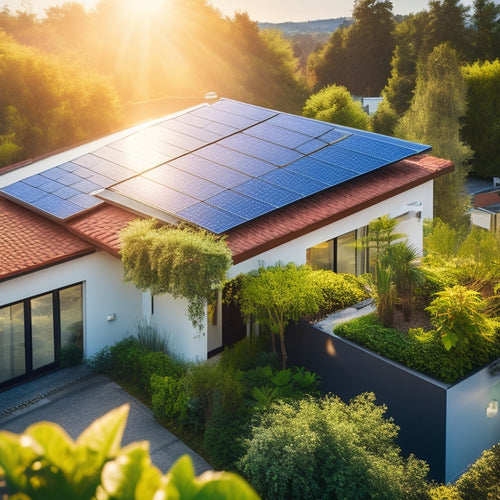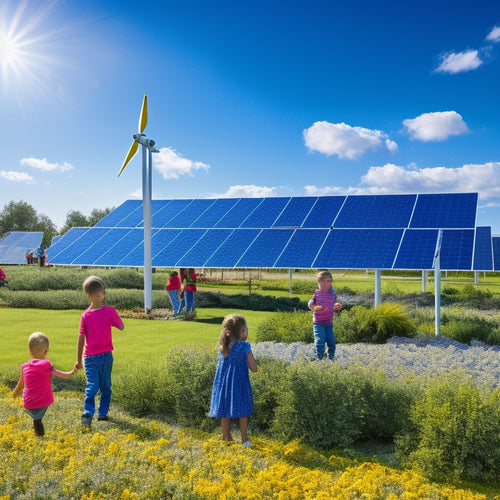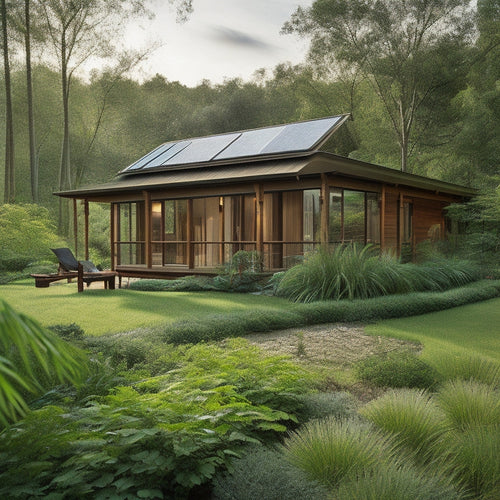
How Does Location Affect the Cost of a Solar Panel Roof?
Share
When considering a solar panel roof, your location greatly impacts the cost. Regional labor costs, which make up 75% of the total installation cost, vary depending on the local labor market. Additionally, local building codes, permitting fees, and incentives also differ by location. Roof size, complexity, and angle, as well as climate and weather patterns, further influence the cost. Proximity to suppliers and logistics, plus competition among installers, also play a role. By understanding how these factors interact in your area, you can better estimate the cost of your solar panel roof – and there's more to investigate to get an accurate estimate for your project.
Key Takeaways
- Regional labor costs significantly impact the overall cost of a solar panel roof, with 75% of the total cost attributed to labor.
- Local building codes, permits, and inspections add to the project cost, with fees ranging from $1,000 to $3,000 depending on project complexity.
- Availability of local incentives, such as rebates and tax credits, can significantly reduce upfront costs, with varying incentives offered by governments and utility companies.
- Roof characteristics, including size, complexity, and angle, affect the number of panels needed, installation complexity, and overall cost.
- Climate and weather patterns influence solar panel performance, durability, and energy production, with understanding local climate crucial for optimization.
Regional Labor Costs Matter
About 75% of the total cost of a solar panel roof installation is attributed to labor costs, making regional labor costs a crucial factor in determining the overall expense of the project.
As you consider installing a solar panel roof, you'll want to understand how regional labor costs impact your project's bottom line. Labor market trends and wage fluctuations in your area will influence the total cost of installation.
For instance, if you live in an area with high labor demand and limited skilled labor supply, you can expect to pay a premium for installation services.
Conversely, if you're in a region with a surplus of skilled laborers, you may be able to negotiate a better deal. Understanding these regional labor cost variations will help you make informed decisions about your solar panel roof installation.
Be certain to research local labor market trends and factor them into your project budget to guarantee you get the best value for your investment.
Local Building Codes Impact
You'll need to factor in local building codes when installing a solar panel roof, as compliance costs can add up quickly.
Obtaining necessary permits and passing inspections will require additional time and resources, increasing your overall project cost.
Code Compliance Costs
As you commence your solar panel roof installation, maneuvering through local building codes becomes a vital step in the process. Code compliance costs can add up quickly, and it's important to understand how they'll impact your project's bottom line.
One significant factor is code interpretation, which can vary depending on your location. In some areas, codes may be more stringent, requiring additional materials or labor to meet specific standards. This can increase your costs and extend compliance timelines.
To mitigate these costs, it's important to work with a reputable installer who's familiar with local codes and regulations. They can help you manage the intricacies of code compliance, ensuring your installation meets all necessary requirements while minimizing unnecessary expenses.
Additionally, be prepared to factor in potential delays due to compliance timelines, which can impact your project's overall duration. By understanding code compliance costs and working with a knowledgeable installer, you can better plan for and manage these expenses, ensuring a successful and cost-effective solar panel roof installation.
Permits and Inspections
Several permits are typically required for a solar panel roof installation, and each one comes with its own set of fees and processing timelines.
You'll need to submit a permit application to your local government, which will then review your plans to guarantee they meet local building codes and regulations. This can take anywhere from a few weeks to several months, depending on the complexity of your project and the workload of your local permitting office.
Once your permit is approved, you'll be cleared to begin installation. However, you'll still need to schedule inspections at various stages of the project to verify everything is up to code.
These inspections can add to your overall cost and timeline, so it's crucial to factor them into your planning. Your contractor should be able to guide you through the inspection timeline and help you prepare for each stage.
Be sure to ask about their experience with local permitting and inspections to facilitate a smooth process. By understanding the permit and inspection requirements in your area, you can better plan your solar panel roof installation and avoid costly delays.
Availability of Local Incentives
One key factor to contemplate when evaluating the cost of a solar panel roof is the availability of local incentives. You may be eligible for solar energy incentives that can greatly reduce the upfront cost of your solar panel roof.
Local governments and utility companies often offer rebates or tax credits to encourage the adoption of renewable energy sources. These incentives can vary widely depending on your location, so it's crucial to research what's available in your area.
You can start by checking with your local government or utility company to see if they offer any local rebate programs. You can also search online for state and federal incentives that may be available to you.
Some popular incentives include the Solar Investment Tax Credit (ITC), which allows you to claim a tax credit of up to 26% of the total cost of your solar panel roof. Additionally, some states offer property tax exemptions or sales tax exemptions for solar panel systems.
Roof Size and Complexity
When determining the cost of a solar panel roof, you'll need to take into account the square footage of your roof, as a larger roof requires more panels and installation time.
The angle of your roof also plays an essential role, as a steeper angle can increase installation complexity and costs.
Square Footage Matters
Determining the size of your roof is essential in calculating the cost of solar panels, as it directly impacts the number of panels you'll need to generate sufficient energy. The larger your roof, the more panels you'll require, and the higher the overall cost.
On average, a typical residential solar panel system ranges from 3,000 to 10,000 square feet.
When considering solar energy trends, you'll notice that urban homes tend to have smaller roofs compared to rural homes. This means that urban homeowners may require fewer panels, resulting in lower costs. Conversely, rural homes often have larger roofs, which can increase the number of panels needed, driving up costs.
To get an accurate estimate, measure your roof's square footage and consider its complexity. A complex roof with multiple angles, skylights, or vents will require more panels and labor, increasing the cost.
Roof Angle Importance
Your roof's angle plays an essential role in determining the overall cost of your solar panel installation, as it affects the system's energy output and installation complexity. A roof with an ideal angle receives more direct sunlight, increasing solar efficiency and energy production.
Ideally, your roof should face between south and west, as this orientation maximizes energy output. However, if your roof faces east or north, you may still generate significant energy, but at a lower rate.
The roof angle also impacts installation complexity. Steeper roofs require more complex installations, which increase labor costs and installation time. Conversely, flatter roofs are generally easier to install, reducing labor costs and time.
When evaluating your roof's angle, consider both its orientation and pitch. A roof with a pitch between 30° and 40° is typically ideal, as it allows for efficient energy production and relatively easy installation.
Climate and Weather Patterns
Regional climate and weather patterns greatly impact the performance and durability of a solar panel roof.
You'll want to evaluate the amount of sunlight your location receives, as it directly affects solar efficiency and energy production. Areas with high levels of cloud cover, fog, or shade will reduce your solar panel roof's ability to generate power. On the other hand, regions with abundant sunlight will increase energy production.
Temperature also plays a significant role. Extreme temperatures, either hot or cold, can reduce the efficiency of your solar panels.
You'll need to confirm your solar panel roof is designed to withstand the local climate conditions. For instance, if you live in an area prone to hurricanes or heavy snowfall, your solar panel roof will need to be reinforced to withstand these weather patterns.
Understanding the local climate and weather patterns is essential for optimizing your solar panel roof's performance.
Proximity to Ports and Suppliers
As you've assessed the climate and weather patterns in your area, it's now important to reflect on the logistics of getting your solar panel roof installed. One vital factor to take into account is your proximity to ports and suppliers. This affects the shipping logistics, which in turn impact the overall cost of your solar panel roof.
If you're located near a major port, shipping costs will be lower, and you'll have access to a wider range of suppliers. This can lead to better pricing and a more competitive bidding process.
Strong supplier relationships are also key. Local suppliers can provide faster delivery times, reducing the risk of project delays. Additionally, they may offer more personalized service, ensuring that your specific needs are met.
Conversely, if you're located far from ports and suppliers, shipping costs will increase, and you may face longer lead times. This can drive up the cost of your solar panel roof installation.
Understanding the impact of proximity to ports and suppliers is vital to making an informed decision about your solar panel roof project.
State and Local Tax Policies
Nearly every state and local government offers some form of incentive for residents and businesses investing in renewable energy, and these incentives can greatly impact the cost of your solar panel roof. As you research the cost of a solar panel roof, it's important to factor in the state and local tax policies where you live.
State incentives and local rebates can greatly reduce the upfront cost of your solar panel roof. For example:
| State/Location | Incentive/Rebate |
|---|---|
| California | 10% state tax credit |
| New York | $1.00/Watt rebate (up to $5,000) |
| Texas | Property tax exemption |
| Massachusetts | 15% state tax credit |
| Colorado | $1,000 sales tax exemption |
These incentives can vary widely depending on where you live, so it's vital to research the specific policies in your area. By taking advantage of these state and local incentives, you can greatly reduce the cost of your solar panel roof and start generating clean energy for your home or business.
Permitting and Inspection Fees
Before installing your solar panel roof, you'll need to obtain the necessary permits and undergo inspections to confirm compliance with local building codes and regulations.
These requirements vary by location, and the associated fees can add up quickly. The type of solar panel you choose can impact the permitting process, as some types may require additional permits or inspections. For instance, building-integrated photovoltaics (BIPV) systems, which integrate solar panels into the roofing material, may require more extensive permits than traditional rack-mounted systems.
The time it takes to obtain permits and complete inspections can also affect your installation timeline. Delays in the permitting process can push back your project's completion date, causing inconvenience and potentially adding to the overall cost.
On average, permitting and inspection fees can range from $1,000 to $3,000, depending on the complexity of the project and the location. It's crucial to factor these costs into your budget and plan accordingly to guarantee a smooth and successful installation.
Competition Among Installers
Frequently, homeowners find themselves maneuvering a competitive terrain when searching for a solar panel roof installer.
You're not alone in this quest, as the market is flooded with installers vying for your business. This competition can actually work in your favor, driving prices down and quality up.
When evaluating installers, it's crucial to assess their reputation, experience, and market demand. Here are three key factors to keep in mind:
-
Installer reputation: Research the installer's track record, including customer reviews, ratings, and warranties offered. A reputable installer will provide high-quality equipment and installation.
-
Market demand: Analyze the level of competition in your area. If there are multiple installers competing for your business, you may be able to negotiate a better price.
-
Regional knowledge: Verify the installer has experience with local building codes, regulations, and climate-specific requirements.
Frequently Asked Questions
Can I Install a Solar Panel Roof Myself to Save on Labor Costs?
You can attempt a DIY installation to save on labor costs, but be aware that it requires significant technical skill and may void warranties, potentially offsetting any initial cost savings.
How Do I Find Local Solar Panel Installers With Good Reputations?
You'll find reliable local solar panel installers by checking online review platforms for high ratings, verifying certifications like NABCEP, and asking about warranties, ensuring a qualified professional handles your solar roof installation.
Are There Any Financing Options Available for Solar Panel Roofs?
As you're coincidentally considering solar panel roofs, you're in luck! You'll find various financing options, including government incentives, to make your eco-friendly dream a reality, such as solar loans, power purchase agreements, and property tax financing.
Can I Use Solar Panels on a Roof With Multiple Skylights?
You can install solar panels on a roof with multiple skylights, but skylight positioning and sunlight exposure will impact energy output; strategically placing panels around skylights and evaluating shading effects will optimize your solar roof's performance.
Will a Solar Panel Roof Increase My Property Value?
As you gaze up at your newly installed solar panel roof, imagine the increased property value shining bright like a guiding light, as a property appraisal will likely reflect the smart solar investment, enhancing your home's worth and appeal.
Conclusion
As you weigh the cost of a solar panel roof, remember that location is the principal key that opens the true price. Like a puzzle, each region's unique combination of labor costs, building codes, incentives, and climate pieces together to form a distinct cost framework. Understanding these factors will help you traverse the complex terrain and find the sweet spot where solar energy meets affordability.
Related Posts
-

Solar Power Systems for Cost-Effective Sustainability
Investing in solar power systems is a smart move for cost-effective sustainability. You can save about $1,500 annuall...
-

Solar Power for Community Energy Independence
Solar power is essential for your community's energy independence, offering both environmental and economic benefits....
-

Affordable Sustainable Building Materials for Homes
You can build an eco-friendly home on a budget by choosing affordable sustainable materials. Consider using reclaimed...


